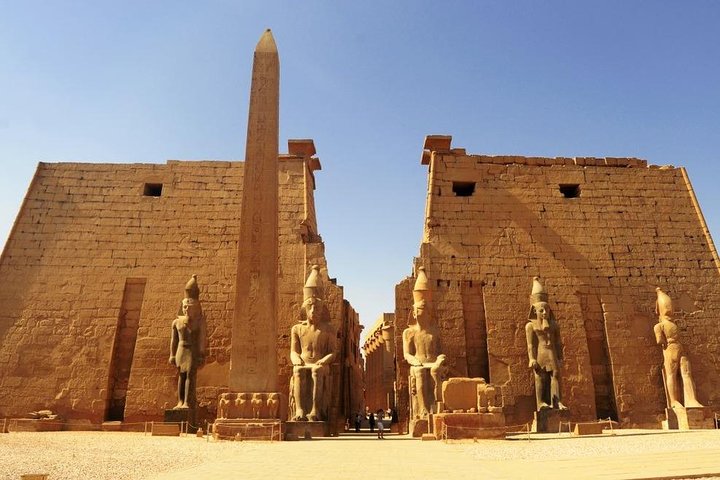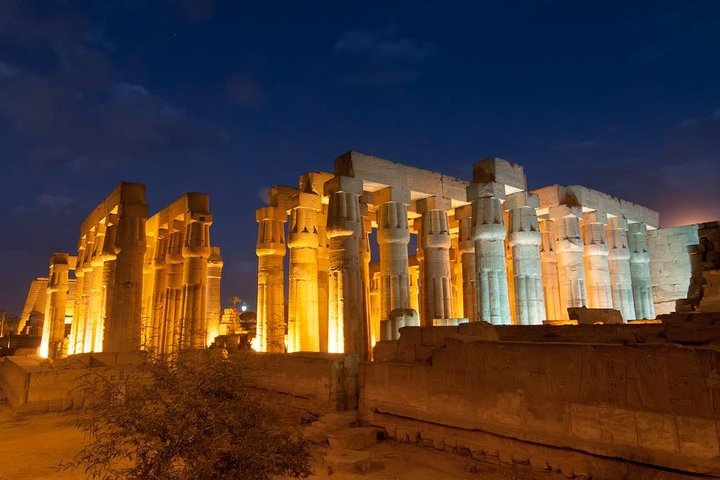Why choose this Luxor tour ?
Luxor is home to some of Egypt’s most remarkable ancient ruins, but group tours can offer limited to time to explore. This private full-day tour ensures a personalised experience and explores both the East and West Banks of the Nile, including the UNESCO-listed Valley of the Kings, the Colossi of Memnon, the temple of Hatshepsut, the Karnak Temples, and the Temple of Luxor.
Make the most of your Luxor adventure
What makes private Tour:Luxor,karnak,Hatshepsut Temples &valley of the kings a unique experience ?
Start Luxor City Tour through transferring to the west bank where you will visit the Valley of the Kings, the magnificence of the grandeur of architecture which was used for burial, there are many kings buried in this valley. The most known tombs are King Tutmosis I, Tutmosis III, Tut-Ankh-Amon, King Ramssess VI, King Mrenptah and AmonhotepII. Move on to visit the Temple of Queen Hatshepsut, which was built by Queen Hatshepsut, daughter of Thutmosis I, who ruled Egypt about 20 years during the 18th Dynasty (approximately 1490-1469 B.C), the only pharaonic woman who reigned ancient Egypt. You will pass by the colossi of Memnon which are remains of the mortuary temple of Amenhotep III. Continue driving to the east bank of Luxor to enjoy having your lunch at a local restaurant, before moving to visit Karnak Temples, the greatest example of worship in the history, dedicated to the God Amon, his wife Mut and their son Khonsu. End your tour by visiting the Temple Of Luxor.
The Valley of the Kings is a renowned archaeological site located on the west bank of the Nile River in Egypt, opposite modern-day Luxor. It served as the burial ground for pharaohs and powerful nobles during the New Kingdom period of ancient Egypt, approximately between the 16th and 11th centuries BCE.
When visiting the Valley of the Kings, there are several notable features and attractions to explore:
1. Tombs: The valley is home to numerous rock-cut tombs, where pharaohs and nobles were buried. While the exact number of tombs is subject to ongoing archaeological discoveries, around 63 tombs have been discovered so far. Notable examples include the tombs of Tutankhamun, Ramses II, and Seti I.
2. Tutankhamun’s Tomb: One of the most famous tombs in the Valley of the Kings is that of Tutankhamun, also known as King Tut. Discovered by Howard Carter in 1922 .
The Karnak Temple Complex is an ancient Egyptian temple located near the modern city of Luxor, on the east bank of the Nile River in Egypt. It is one of the largest and most impressive temple complexes in Egypt and was dedicated primarily to the worship of the god Amun-Ra, although it also includes other smaller temples and sanctuaries dedicated to various deities.
The construction of the Karnak Temple Complex began in the Middle Kingdom, around 2000 BCE, and continued over a period of approximately 1,500 years, with successive pharaohs adding their own contributions. As a result, the complex represents the combined efforts of many generations of pharaohs and reflects different architectural styles and religious beliefs.
The centerpiece of the Karnak Temple is the Great Hyp
Luxor Temple, also known as the Temple of Luxor, is another ancient Egyptian temple located in the city of Luxor, on the east bank of the Nile River. It is situated right in the heart of the modern city, making it easily accessible to visitors.
Luxor Temple was built primarily during the New Kingdom period of ancient Egypt, around the 14th century BCE, although later pharaohs also made additions to the temple. It was dedicated to the Theban Triad, consisting of the gods Amun, Mut, and their son Khonsu.
The temple complex is known for its impressive architecture and grandeur. It features a large colonnade, massive pylon gateways.
The two statues depict Amenhotep III seated on a throne. They stand about 60 feet (18 meters) tall and weigh an estimated 720 tons each.
– The statues originally stood at the entrance to Amenhotep III’s memorial temple, which was one of the largest and most magnificent temples in ancient Thebes. Unfortunately, the temple itself has been largely destroyed over the centuries.
– In 27 BC, one of the statues was damaged by an earthquake, causing it to produce a musical sound at sunrise, which was believed to be the “cry of Memnon” – Memnon being an Ethiopian king in Greek mythology. This phenomenon drew many ancient tourists to witness it.
Tour Description & Additional Info:
- Infants are required to sit on an adult’s lap
- Service animals allowed
- Public transportation options are available nearby
- Infants and small children can ride in a pram or stroller
- All areas and surfaces are wheelchair accessible
- Transportation options are wheelchair accessible
- Wheelchair accessible
- Suitable for all physical fitness levels
Options To Choose for Your Trip:
private Tour:Luxor,karnak,Hatshepsut Temples &valley of the kings Inclusions:
Included with Your Ticket
- Entrance fees to all the mentioned sites
- Lunch at a good quality restaurant
- Private English-speaking Egyptologist guide
- Pick up services from your hotel in Luxor and return
- All transfers by a private air-conditioned vehicle
- Bottled water on board the vehicle during the tour
Not Included
- Tipping
Trending Luxor Nearby Tours Likely To Sell Out
Special Instructions:
- This Tour is Provided by Egypt Lovely Tours.
- Tour Timezone & Starts at Africa/Cairo.
- Mobile or paper ticket accepted.
- For a full refund, cancel at least 24 hours before the scheduled departure time.
- This Tour is Rated 5 Stars based on 12 valid reviews on TRIPADVISOR.
- Minimum 1 Travelers is required to book.
- Maximum 15 Travelers is accepted for booking.









